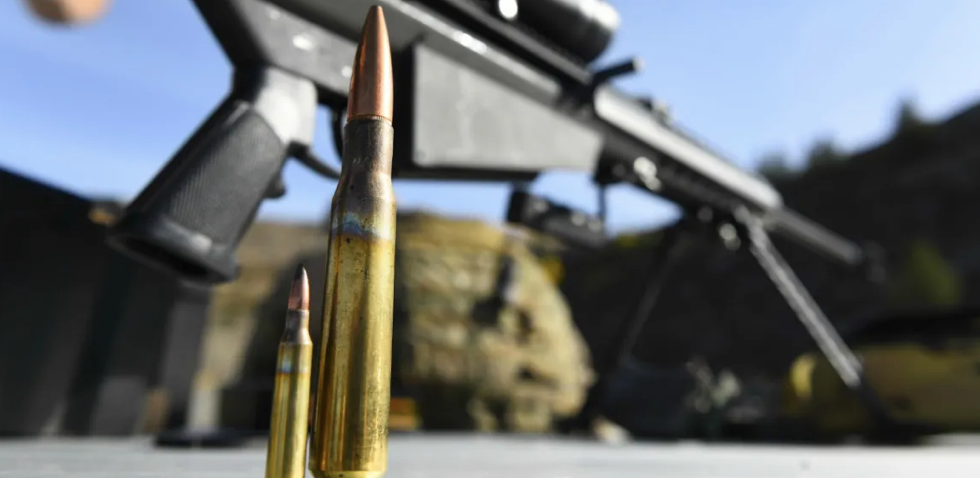Myths and Misconceptions are rife amongst gun owners, and although they generally don’t do too much harm, they’re better off debunked. But why do so many myths and misconceptions continue making the rounds amongst gun owners?
Well, who knows? Maybe they want to seem well educated in their field of interest – that being firearms – and are therefore happy to pass knowledge onto those around them without fully understanding or verifying the facts. For whatever reason, it happens.
So let’s take a look at the following statements, and then discuss whether they are “Confirmed” or “Busted” – Mythbusters style.
- A .50 caliber bullet can rip off limbs without even making contact – by sheer velocity.
- Snipers are capable of first rounds hits with any rifle, even one which is unfamiliar to them – it’s the shooter, not the rifle.
- Keeping magazines loaded with ammunition wears the springs; they need to rest.
- An increase in humidity causes a bullet to slow down faster, as the air is thicker.
- My rifle groups sub-MOA at 100 meters; I therefore have a sub-MOA rifle.
- Bullets cannot kill or injure someone under water.
- The best person to mount & setup your rifle scope is a gunsmith.
- Shorter barrels aren’t good for long distance shooting.
- Suppressors increase a projectile’s velocity, and therefore increase the rifle’s effective range.
- Shooting through heavy or thick rain can deflect your bullet and lead to a miss.
1. Can a .50-Cal Sniper Bullet’s Shockwave Kill?
A .50-cal sniper bullet can kill or tear off limbs merely by passing close enough to a target; the shockwave is tremendous.
Statement made by many a people
This one may be a little disappointing, because the answer may not be as exciting as you’d have hoped, but no it cannot. In fact, the shockwave can’t even knock over a playing card. Don’t believe me? Watch the video below.
Verdict: can a .50-cal sniper bullet’s shockwave kill: BUSTED
2. Are Snipers Capable of First Round Hits Over Long Distances with an Unfamiliar Rifle?
This one is super common in Hollywood films, whereby a sniper or a trained marksman will pick up a rifle from the ground, or a downed enemy combatant, and use it to engage numerous targets over various distances with pinpoint accuracy.
Realistically, this is completely inaccurate.
- First of all, the weapon needs to be inherently capable of achieving this accuracy, meaning that it needs to be setup correctly and of a real high quality.
- Second, the scope (if the rifle has one) needs to be setup to the shooter’s eye relief, spot weld, and length of pull, if this pinpoint accuracy is to be achieved.
- And finally, the shooter needs to know the trajectory of the rifle/bullet he is shooting, and with endless possibilities, this is highly unlikely under this scenario. The shooter would need to know the bullet’s weight and ballistic coefficient, the muzzle velocity of the rifle, the external temperature and pressure… the list goes on.
An experienced shooter can however, in some cases, engage successfully with a follow-up shot. This relies on the inherent capability of the rifle, scope and ammunition, and a favourable environment surrounding his target that allows the shooter to spot his bullet’s impact and adjust the shot accordingly.
Verdict: can a sniper achieve pinpoint first round hits over long distances with someone else’s rifle: BUSTED
3. Does Keeping Magazines Loaded Wear the Springs?
Most shooters who have owned a firearm long enough have had this discussion at least once; if kept loaded for extended periods of time, the magazine springs will wear out and cause problems when trying to use it. So do magazine springs really need to rest or take a break every once in a while?
If you’d like to remain on the conservative side, a clean and light oil of your magazine springs every 90-days is recommended by some manufacturer’s, however, modern magazines have tempered springs which are well made, and although they may take a little bit of set, they will still function just fine if kept loaded for years on end.
Note: defensive carry magazines should be maintained and tested regularly.
Verdict: keeping magazines loaded with ammunition wears the springs and causes feeding issues: BUSTED
4. Does Humidity Cause a Bullet to Slow Down Faster?
Humidity is one of three atmospheric conditions that affects a bullet during flight. Temperature and pressure are the other two. Common sense would tell us that a higher humidity (a thicker feeling to the air), would cause a bullet to slow faster in more humid regions. Wrong!
Higher humidity actually results in thinner air, despite how it feels against the skin, and has the opposite ballistic effect to what most would imagine. A bullet travels easier through humid air, as water in its gas form displaces the air molecules and actually results in less matter for the bullet to pass through.
The good news is that the noticeable effect on trajectory caused by humidity is most often negligible, so don’t be too concerned over this one.
Verdict: an increase in humidity causes a bullet so slow down faster: BUSTED
5. My Rifle Groups Sub-MOA at 100m, Does this mean I have a Sub-MOA Rifle?
It is very common nowadays for shooters to achieve sub-MOA results during load development or zeroing exercises, even with factory rifles. I for example have a factory Remington 700 (6.5 Creedmoor) which produces 13mm groupings at 100 meters with my best load. So does this mean that I have a 1/2 MOA rifle?
Not necessarily. This is because the grouping needs to be verified at various distances. A rifle that shoots half minute of angle groups at 100 meters may not achieve these groups at furthers distances, even if all external factors and wind have been accounted for correctly.
The reason often comes down to variation in muzzle velocity, or incapable ammunition. Once muzzle velocities are sitting extremely close to one another, or duplicating shot after shot, you are one step closer to designating your rifle with the title of sub-MOA; provided the shooter and bullet are capable. For a better understanding, read the following article – The Long Range Effects on Muzzle Velocity Variation.
Verdict: do sub-MOA groupings at 100 meters classify a rifle as sub-MOA: this one is a little more complicated, but unless the shooter has verified this out to distance, it is BUSTED
6. Can You Hide from Bullets Under Water?
Another perfect example of Hollywood’s inaccurate depiction of ballistic science – this one is in fact true. Bullets do come to an extremely accelerated stop when travelling through water. How many feet or meters the bullet will travel depends entirely on the caliber and speed of the projectile.
According to Mythbusters extensive testing on the subject (Season 3, Episode 11), supersonic bullets (up to .50-cal) disintegrated in less than 3 feet (90 cm) of water, while slower velocity bullets like pistol rounds need up to 8 feet (2.4 m) of water to slow to non-lethal speeds. However, as most water-bound shots are fired from an angle, less actual depth is needed to create the necessary separation – angle dependant of course.
Verdict: can you hide from bullets underwater: CONFIRMED
7. A Gunsmith or Firearms Dealer should Setup your Riflescope for Best Performance?
Believe it or not, this is common belief amongst less-experienced rifle owners; that you should hand your rifle and scope into a dealer so that they can correctly mount and setup your scope for best performance.
This is completely false. Why would you ask someone else to setup a scope that in fact needs to be tailored to your own shooting style? Correct eye relief, positioning of your cheek onto the rifle’s stock while looking down your scope, and positioning of the scope in relation to your length of pull needs to naturally fall in line with your own body (and head) position when firing your rifle.
My best advice is to therefore learn how you properly mount and level your scope by yourself, with the help of a friend or family member if needed.
Verdict: a gunsmith or firearms dealer should setup your riflescope for best performance: BUSTED
8. Shorter Barrels Aren’t Good for Long Distance Shooting
There are many debates that take place over barrel length, and which is more suitable towards long range shooting. But the general chain of thought by many is that shorter barrels aren’t ideal for long range application.
This is not the case. While there will be a fairly significant effective range increase between let’s say a 16-inch barrel and a 26-inch barrel firing the same cartridge, the 16-inch barrel will still be capable of long range accuracy, provided the rifle is setup correctly. But when selecting barrel length based on performance, it typically comes down to a difference of only 2 – 4-inches, give or take some.
A 4-inch difference in barrel length will result in a range increase of around 40 – 50 meters, which is not astronomical. Besides, the shorter barrel does come with some advantages of its own.
To read more about the advantages of a longer (or shorter) barrel, read our article titled: Is a Longer Rifle Barrel more Accurate?
Verdict: shorter barrels aren’t good for long distance: BUSTED
9. Do Suppressors Increase Velocity and Effective Range?
Is it believed by many that suppressors effectively increase barrel length, which in turn increases the bullet’s velocity and extends the capable accurate range of the projectile. I have personally heard a number of shooters claim that they themselves have witnessed a fairly significant increase in effective range when a suppressor is fitted to their rifle.
Now to the truth: fitting a suppressor does not increase velocity, at least not enough to notice any difference in your effective range. The video below shows a good example, whereby the suppressor produces a difference of only 14fps or 4mps in velocity. This equates to a range increase of only 3 meters. A 5°C shift in temperature is likely to have more of an effect in terms of velocity and effective range, so make of that what you will.
Verdict: adding a suppressor to your rifle will increase velocity and effective range: BUSTED
10. Can Shooting Through Rain Deflect your Bullet?
This one is a little more tricky, as there is little scientific evidence to backup the answer, which just by the way is NO. Shooting through rain (no matter how thick) does not deflect your bullet.
One theory is that the bullet flies so fast through the air that the chances of it making contact with a rain drop are unlikely. A more convincing theory is that the envelope of air (shockwave) that travels forward of a supersonic bullet, disintegrates or deflects water droplets along its flight path.
But regardless of which theory one believes, the majority of experienced long range marksmen will admit that rain has no noticeable effect on a supersonic projectile’s flight path.
Verdict: shooting through thick rain drops can deflect your bullet: BUSTED
Summary
I enjoyed writing this article, and hope that you enjoyed reading it. Please feel free to comment below, like our facebook page, and share our 10 Shooting Myths and Misconceptions Debunked with friends and family, and keep a lookout for out latest blogs and reviews.


4 thoughts on “10 Shooting Myths and Misconceptions Debunked”